Pond Liner info with Darrell Rhoades and Jim Nicholson
Our featured expert this week is Jim Nicholson.
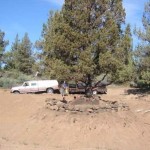 Jim has been in the pond industry for many years, extremely knowledgeable and knows the importance of getting the job done right the first time.
Jim has been in the pond industry for many years, extremely knowledgeable and knows the importance of getting the job done right the first time.
Be sure to listen to the audio to learn more about Jim and the ultimate in pond liners. When contacting Jim be sure to let him know Darrell Rhoades from WhatPond sent you to receive your discount. Contact info and audio is at the end of this post.
What happens if you’re location does not offer enough clay content to hold water?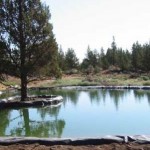
Yep you will end up with time and money spent just to have a bowl or depression in the ground that does not hold water. That would be depressing unless you had alternate plans of 4 wheeler play ground or cement it for a great skate arena. All kidding aside this is a tragic thing to happen, after all the work and anticipation of having a great pond just to find it won’t hold water. Be sure to plan ahead to include the costs of a pond liner.
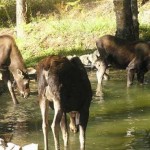 There is a fix for this but needs to be thought of before hand, as an additional cost to pond building. And that thought is using a pond liner that will hold the water and strong enough to hold the weight of the water. One gallon of water weighs, on average, 8.3 pounds, a one acre pond holds 1 million gallons of water, that equals 8,3000,000 lbs of water in the pond. Now that is not all in one spot but it is spread out over the entire pond. The bottom will have the most water pressure, then the sides.Coming up the sides the pressure will be less at the shore line.
There is a fix for this but needs to be thought of before hand, as an additional cost to pond building. And that thought is using a pond liner that will hold the water and strong enough to hold the weight of the water. One gallon of water weighs, on average, 8.3 pounds, a one acre pond holds 1 million gallons of water, that equals 8,3000,000 lbs of water in the pond. Now that is not all in one spot but it is spread out over the entire pond. The bottom will have the most water pressure, then the sides.Coming up the sides the pressure will be less at the shore line.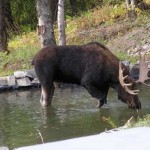
This is where the pond liner comes in to play. Having the strongest liner will help in assuring your success in the ultimate pond.
T0 learn more check out the Technical section.
Be sure to tell Jim Nicholson that Darrell Rhoades from WhatPond says hello.
Click the Play button below,
RPE is a little less “bendable” than EPDM rubber, but it is still more than flexible enough to bend around corners, bends and shelves in a pond. For a visual comparison between RPE and EPDM rubber, please watch the below video. Even though RPE is a little less flexible than EPDM, it’s around 3 x stronger, which really helps create a more reliable liner installation that is less likely to tear or puncture.
UV Resistance
As long as our premium grade RPE liner is covered with water, or some kind of fill or protective layer, we guarantee a life of at least 20 years. If the liner is taken care of, you could easily see 20, 30 or even 40 years life. If the liner is directly exposed to the sun and is not covered with water, soil or another material, the liner should still last around 10 years before it succumbs to UV damage and needs to be replaced. If you need even more life when directly exposed to the sun, please have a look at the 40 mil extra strength liner has an expected life of 15 years when directly exposed to the sun.
RPE liner is warranted to be free from defects in material and workmanship for 20 years from the day of purchase. This includes the ability of the liner to withstand normal weathering and environmental degradation when used as a primary containment membrane holding water. There are a few limitations however for the warranty to be valid: The liner must be covered at all times by soil or water, the warranty is not covered against damage resulting from acts of god, or catastrophic events such as earthquakes, tornadoes, or hurricanes. The liner is also not covered against punctures or damage resulting from improper installation, or use. Examples of improper installation or use include damage by machinery or other equipment, people, animals, ice, or sharp/rough objects in the soil or substrate.
RPE liners are initially manufactured in long rolls that are 12’ wide (except for the 40 mi liner which is 10’ wide). To make a specific liner size, we then heat-weld 2 or more liner sheets together, creating high quality heat-welded seams in the liner. These heat welded seams are guaranteed not to leak and carry our full warranty like the rest of the liner. All Liners weighing less than 150 lb. are then packaged into a box and shipped via UPS ground, which takes between 3 to 6 business days depending on your location in the USA. Anything larger is shipped via freight truck on a pallet. The liner comes packaged in a roll. The first step to installation is to place the liner in one corner of the pond so that you’ll be unrolling the liner in the long direction of the pond. For example for a 60′ x 30′ pond, the long direction will be the 60′ edge. After unrolling, the liner is now accordion stacked, which means you can grab the top edge of the liner and pull it across the width of the pond. For every 12′ of liner, it helps to have one person helping to pull. So for a 48′ long liner, you’d want to have at least 4 or 5 people to help pull the liner across the width. If you’re dealing with a very large liner that is very heavy, such as a liner that is over 150′, you may want to unroll the liner down the middle of the pond instead of the edge. This way, you have less material to pull across the width since you would only have to pull the liner across half the width at a time.
Covering the Liner
Covering the Liner in Natural Ponds with Sloping Walls:
What are the ADVANTAGES of a RPE (reinforced polyethylene) liner over EPDM rubber?
The main advantage is the strength and weight of the liner. RPE is considerably lighter than EPDM, and even though it’s thinner, it is more puncture resistant. In some cases, if the RPE membrane is being placed on regular soil or sand, then no protective underlayment is needed.
What are the DISADVANTAGES of a RPE (reinforced polyethylene) liner over EPDM rubber?
Despite being lighter and stronger, RPE is a little less pliable than EPDM. This usually isn’t that big of a deal though for most ponds since the RPE liner can still easily be folded and pleated.
Because of its high puncture resistance, the EP-RPE liner doesn’t need a protective underlayment if being placed on clean soil or sand. In the event of laying the membrane against rock, gravel, or soil with rock, then a protective underlayment should be used to prevent a possible puncture.
Does the EP-RPE liner need to be covered with anything before the pond can be filled with water?
EP-RPE is a UV stable product. Below water level, it is not necessary to cover or bury the liner for extended performance. However, even though the liner is UV stable, we still recommend covering the liner above water level with something since even the most UV stable products can lose their flexibility over extended periods of times. Covering the liner above water level provides aesthetic benefits as well. By covering the liner with rocks, plants or other coverings, it helps to create a more natural looking landscape. If putting soil or sand on top of the liner and the edges of the pond are sloped, it might be a good idea to place a geotextile fabric over top of the EP-RPE liner to prevent the sand/soil from sliding/slipping down the slope.
We recommend a maximum slope of 6 to 1 if there is no geotextile fabric over top of the liner. Anything steeper than that may result in the ballast material (sand, gravel, soil etc) sliding down the liner towards the middle of the pond. By adding a geotextile fabric over the liner, steeper slopes can be achieved.
Is some kind of ballast material necessary to hold the liner down and keep it from floating?
Yes, it’s a good idea to use something to anchor the liner to the bottom of the pond and prevent it from moving/floating. This can be achieved with sand, small gravel, or larger heavier objects strategically placed throughout the pond.
For ballast material, we typically say gravel less than 1″ in size doesn’t require a protective layer over top of the liner. The larger the aggregate size, the more likely it is to damage the liner when spreading out the material , so if using a 1″ piece, spread the material out carefully. If using ballast over 1″ in size that has sharp corners and edges (like crushed gravel), we recommend a protective geotextile fabric to help prevent damage to the liner.
The liner is generally accordion stacked, and then rolled into a roll for shipping. To install, first start by placing the roll at the corner of the pond, so that it will unroll in the long direction. For example, if your pond is 20′ x 40′, the long direction is the 40′ edge. After rolled out along the long edge, grab the top edge of the liner and pull it straight across the width of the pond. Depending on the size of the liner, you may need a number of people to help pull.
Best sellers are our BTL 24 (.39cents Koi Pond & Watergardens), BTL 30 (.49cents) and BTL 40 (.61 cents). Contact Us for help with sizing. Pricing is subject to change, for reference only. Shipping applies as well.

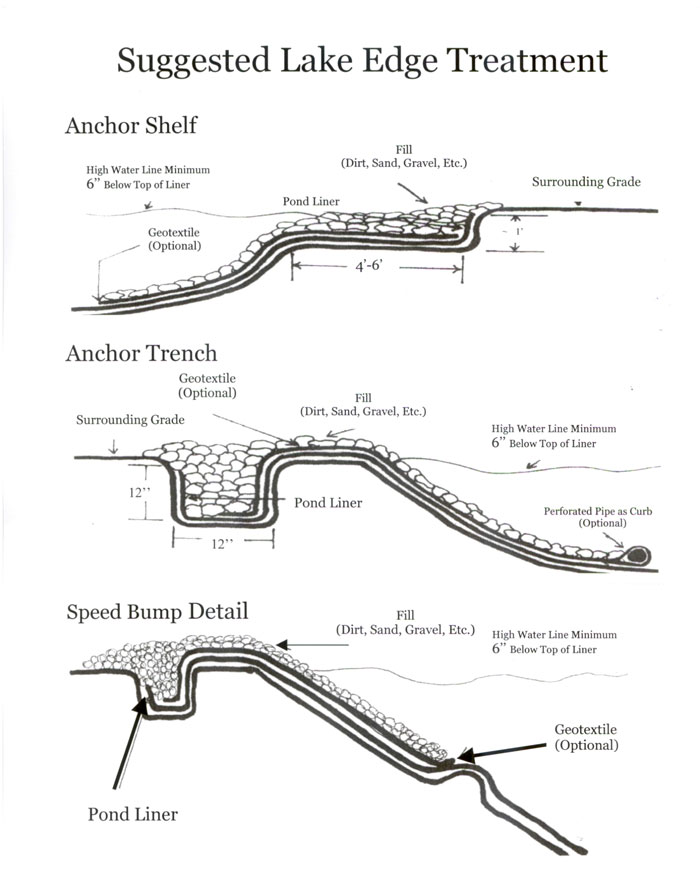
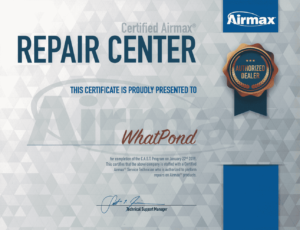
Comments on this entry are closed.
looking for the pondseal in pellets. 50 bags in strawberry arizona
HI Mike, at the bottom of the page Pond Seal is more information.
Thank you.